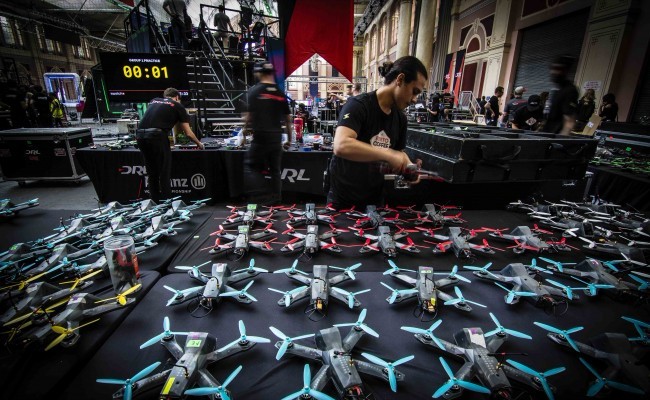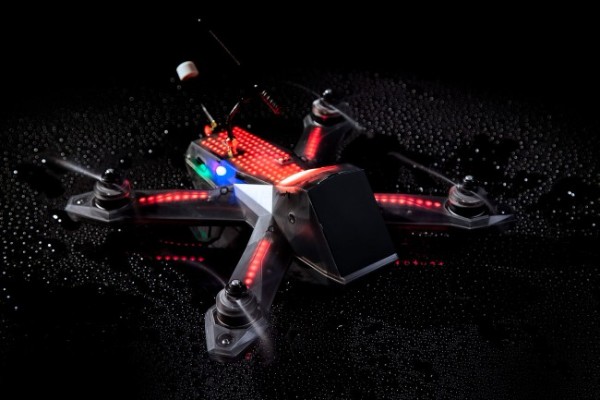
Some stories are simply unbelievable. The Allianz Drone Racing League, which was drawn up during a meeting in a vacant lot behind a Home Depot in Long Island and now broadcasts to more 75 countries in just over three years, is one of those stories.
Enter Nicholas Horbaczewski, who before starting the league found success as the Chief Revenue Officer of Tough Mudder. In early 2015, Horbazewski left his job with the hopes of starting his own company.
“Whenever I’d talk to someone about the different startup concepts, their eyes would immediately light up when I mentioned drone racing,” Horbazewski says. “They’d start comparing the sport to Star Wars or their favorite video game from growing up and pitching ideas on how to develop it, what it could like, where the races could be held. It was those conversations that helped me realize that building DRL was a risk that I truly wanted to take.”
The desire to take that risk led Horbaczewski to a Home Depot with Ryan Gury, now the Director of Product for the Drones Racing League. Gury, prior to meeting with Horbaczewski, had been working on his own company called DroneKraft, in which working people could make their own high-performance drones, complete with first-person vision goggles. It took one meeting and a field test with a drone to dictate what Horbaczewski’s next move would be. In fact, Horbaczewski was so captivated that he later bought DroneKraft.
“I was captivated by the speed and excitement,” Horbaczewski says. “I immediately saw the potential for the sport to grow into something bigger than it was, and we got to work on building out the technology, media and sports ecosystem required to professionalize drone racing and bring it to a global fan base.”
Any kind of startup would feature a myriad of challenges. Getting the DRL off the ground was no different, and required taking an innovative approach. The company spent its infancy working out what cameras they were going to use to film everything, how to create an interesting product for mass consumption, and most of all, trying to find a market for what was a niche sport confined to Reddit and message boards. Oh, and there was also the matter of trying to figure out how to produce drones.
“When we were starting DRL, we spent months meeting with dozens of vendors and drone experts who recommended circuit boards, flight controllers, and other gear to help us develop high-speed racing quads,” Horbazewski says. “However, each time we put the parts together, we learned that there was no end to the ways the drones would fail, from barely lifting off to crashing immediately once up in the air.”

Rather than dealing with vendors, Horbaczewski and the crew cut out the middle man. They’d build the drones up from the circuit boards, customizing them each step of the way. Twenty-six patents and 600 drones later, the group had a fleet of drones ready to fly. One of the key patents that makes the DRL so unique is the advanced radio system which allows a drone to fly as far as a mile and a half away from its operator while feeding the driver real-time information through their FPV goggles.
“We realized that drones had to go beyond line of sight,” Gury says. “No one wants to see a bunch of drones in a field in a single room. They wanna see them go from multi-story environments to mile-long courses. That radio system is the backbone to how we deliver an event, something we constantly innovate on. It really allows the drones and the pilots to fly with a proper video feed way beyond line of sight, and perform a drone race like it should.”
These recent innovations have made other companies stand up and notice the DRL, one of them being automaker BMW, who announced a partnership with the DRL. One of the races for the DRL will be take place at their famous testing track in Munich, BMW Welt. Along with having a race there, the partnership will also allow the DRL to set the Guinness World record for the fastest racing drone, a record the company already owns.
“It’s just a really beautiful building,” says Ashley Ellefson, Director of Operations for DRL. “Playing around with how do we integrate the cars into the background, how do we leverage this very cool kind of bridge that goes down the middle of the venue, so how can we leverage that, put audience on, and feel like they are inside the course, which is not something we’ve been able to do elsewhere. We say this when we’re looking for new venues as well, imagine you’re a bird and where would be a cool place to fly in the venue, because they really can go places that you can’t with car racing or motorcycle racing, it is genuinely three-dimensional.”
Ellefson, like Horbaczewski, came from Tough Mudder and is responsible for designing a lot of the courses for the races. For example, some races will require navigating a certain distance, like last season’s event in Hard Rock Stadium in Miami, which featured racers chewing up space in a hurry as they made tight turns down hallways, racing down sidelines all while being challenged in all three dimensions of reality.
“We get a lot of inspiration from the venue itself,” Ellefson says. “So one key part of my role is securing our venues and really working with different teams here to figure out where are we going, what would make for a great course for the pilots, what’s gonna look great on TV, where can we host audiences, and really balancing all of those factors, and so we look for unique venues that have their own character.”
What makes the DRL one of the fastest growing leagues is its accessibility. If someone wanted to break into the sport right now, all they’d have to do is download the official DRL simulator on Steam to get a feel for the current models the league has to offer. If the racer feels like they’re good enough, they can compete in a simulation league and win a contract of $75,000 to race in the league that following season. The most recent of the tryouts saw 25-year-old Brodie “Robogenesis” Springer wipe the floor the with competition to earn a contract to compete in the upcoming season.
Beyond the accessibility of the league, Gury has a theory as to why the popularity of the DRL is only increasing.
“You have instant acceleration,” said Gury. “There’s no zero-to-60; it’s just there. You can go up, down, left, and right. You can really push the limits of inertia and gravity way beyond typical car racing. When it all boils down to it, it’s the access of speed, right. Going fast.
“When you put the goggles on, you really do believe that you’re on the drone. You really do feel that level of speed. Every time I fly I get somewhat nervous, and there’s no risk to it. I can destroy the drone and not get hurt but there’s no greater form or speed than there is with drone racing. You just can’t go that fast in anything else.”






